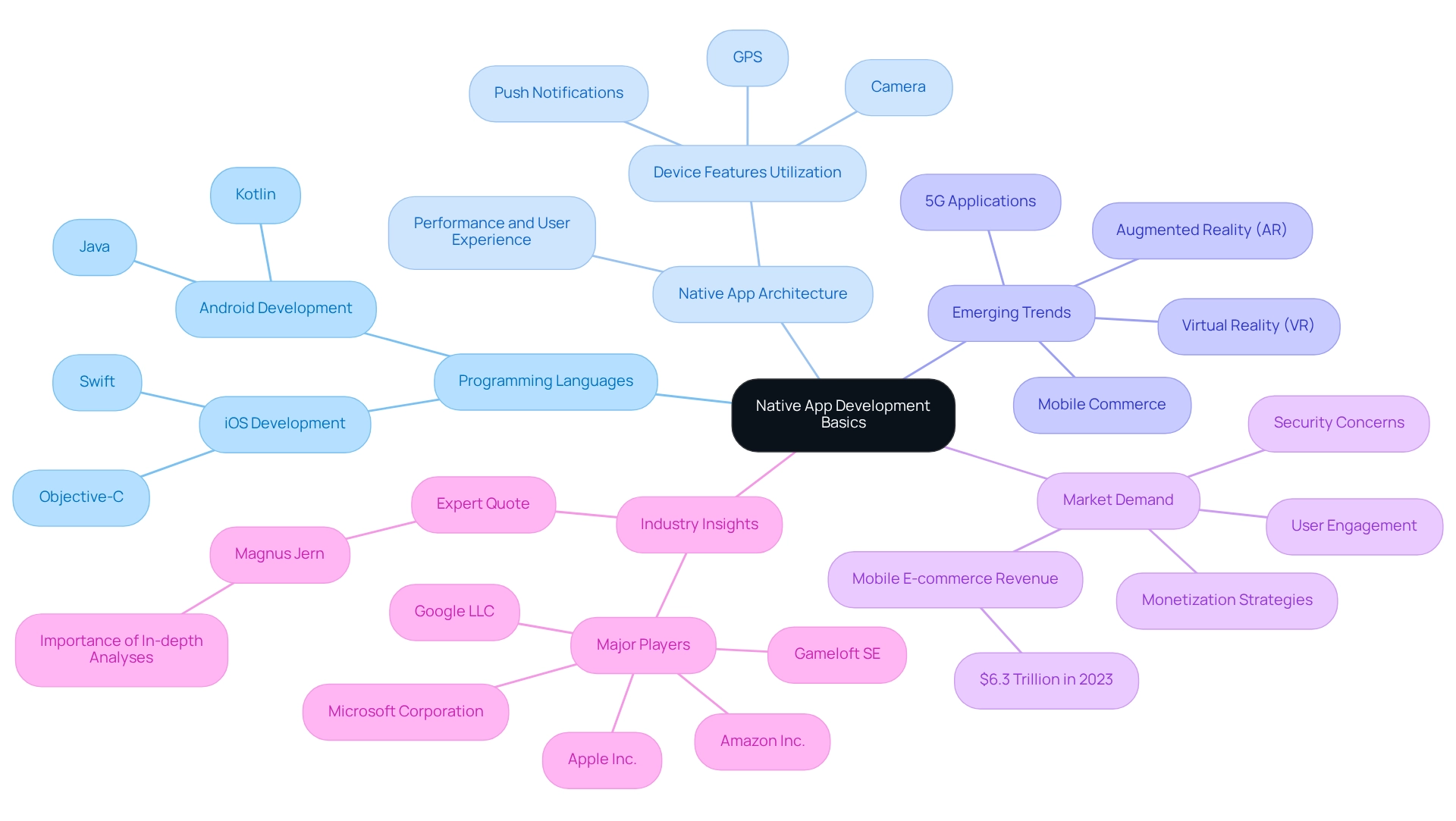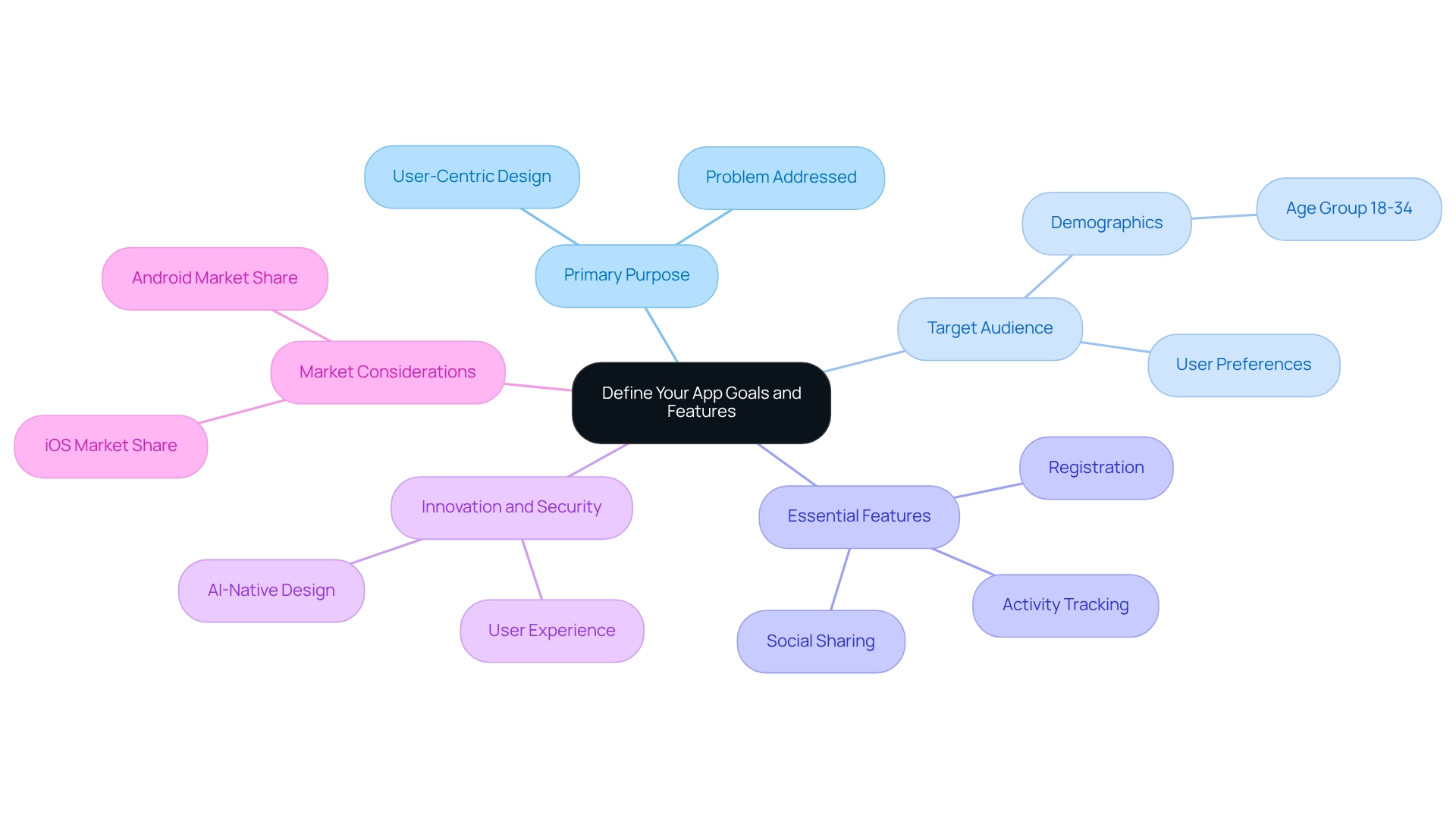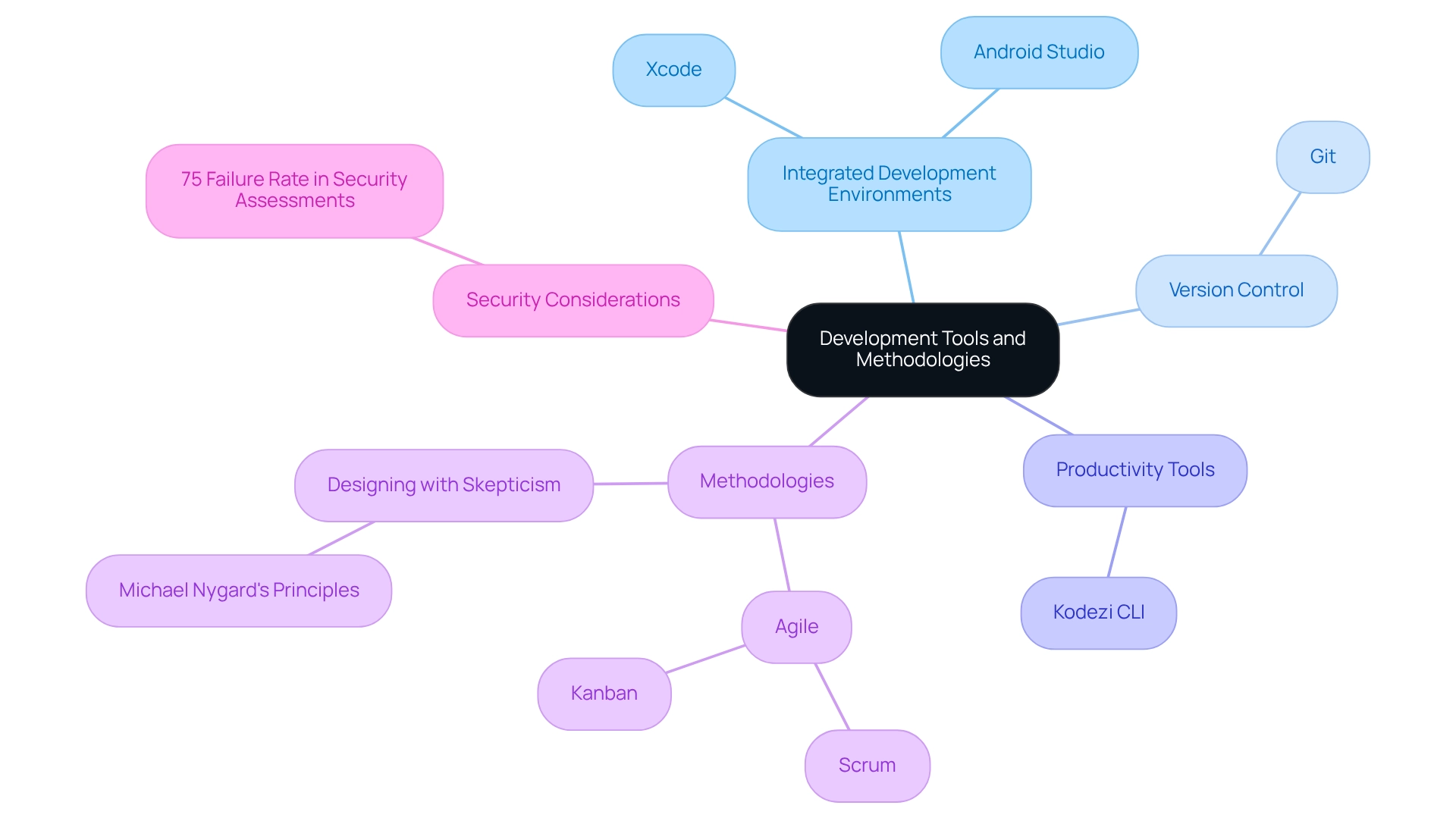Overview
Developing native apps efficiently involves five essential steps that every developer should consider.
- Understanding the basics of native app development is crucial. What challenges do developers face in this area?
- Defining app goals and features sets a clear direction for the project.
- Selecting appropriate tools and methodologies is also vital—how do you choose the right resources for your needs?
- Implementing testing and quality assurance strategies ensures the app functions as intended.
- Effectively deploying and maintaining the app is necessary for long-term success.
Each of these steps is supported by insights into market trends, the importance of user-centric design, the necessity of robust testing protocols, and the significance of ongoing maintenance and user feedback. By focusing on these elements, developers can enhance the performance of their native applications in a competitive landscape.
Introduction
In the dynamic landscape of mobile application development, developers face numerous challenges in delivering exceptional user experiences. Native app creation stands out as a crucial focus, particularly in response to the ever-increasing demand for high-performance applications that seamlessly integrate with device capabilities.
Understanding the fundamentals of native app development is essential for developers aiming to thrive in this competitive environment. Furthermore, as the mobile market continues to evolve, trends such as 5G connectivity and augmented reality are reshaping user expectations. These developments push developers to innovate and adapt, creating an urgent need for effective strategies.
This article delves into the essential steps for successful native app development:
- Defining clear goals and features
- Selecting the right tools and methodologies
Ensuring that developers are well-equipped to meet these challenges head-on.
Understand Native App Development Basics
To create applications tailored specifically for platforms like iOS and Android, it is essential to develop native apps. Developers utilize platform-specific programming languages, such as Swift or Objective-C for iOS, and Java or Kotlin for Android. A solid understanding of native app architecture is crucial, as it allows developers to effectively harness device features like GPS, camera, and push notifications. This capability not only enhances performance but also significantly improves user experience, which is crucial when we aim to develop native apps that are more responsive and reliable compared to hybrid or web applications.
In 2025, the mobile application market continues to thrive, with developers looking to develop native apps that capture a significant share due to their superior performance and engagement. Recent trends emphasize the growing importance of:
- 5G applications
- Augmented reality (AR)
- Virtual reality (VR)
- Mobile commerce
These trends collectively drive the demand for high-quality native applications. As the mobile e-commerce sector reached an impressive $6.3 trillion in 2023, the need to develop native apps has never been more critical. This growth underscores the importance of developing applications that can effectively leverage emerging technologies.
Industry leaders highlight that understanding the nuances of native app creation is vital for developers aiming to build successful applications. Magnus Jern notes, "While the figures given offer a ballpark estimate, it’s crucial for businesses and individuals to conduct in-depth analyses, consultations, and market research." By focusing on the distinct benefits of native architecture, developers can ensure their apps not only meet but exceed expectations, ultimately leading to increased retention rates and enhanced monetization strategies. Furthermore, key players in the mobile application market, such as Apple Inc., Google LLC, and Microsoft Corporation, significantly influence trends and consumer choices, underscoring the competitive landscape that developers must navigate.

Define Your App Goals and Features
Begin by clearly defining the primary purpose of your app. What specific problem does it address? Identifying your target audience is equally important. Understanding these elements is crucial for effective app development in 2025, especially when we aim to develop native apps with a user-centric design. Once you have this foundation, compile a list of essential features that align with your app's goals. Prioritize these features based on client requirements and technical feasibility. For instance, in a fitness tracker application, key features might encompass:
- Registration
- Activity tracking
- Social sharing capabilities
Employing tools like client stories or feature prioritization matrices can assist in clarifying and structuring your app's goals.
In today's competitive environment, where 68% of US gamers fall within the 18-34 age range, how can you customize your app to align with the preferences of this group? Successful app developers emphasize the importance of identifying the target audience early in the development process to effectively develop native apps. Furthermore, mobile app developers need to prioritize innovation, security, and the ability to develop native apps to thrive in this competitive market. The pandemic has accelerated the adoption of health and wellness apps, making it essential to consider these trends when defining your app's goals and features. For example, the transition towards AI-native app design highlights the necessity for ongoing adaptation and hyper-personalized experiences, which can considerably improve satisfaction and engagement.
Additionally, with iOS capturing approximately 57.68% of the market and Android holding around 42.06%, understanding platform considerations is crucial. By focusing on these strategies, you can ensure that your app not only meets user needs but also stands out in a crowded market.

Select Development Tools and Methodologies
Selecting the appropriate tools for creation is essential to develop native apps that align your team's abilities with the specific needs of your app. For iOS programming, Xcode stands out as the main integrated environment (IDE), while Android Studio is the preferred option to develop native apps for Android. Both tools provide strong features customized for their respective platforms, allowing developers to develop native apps with a smoother creation experience. In 2025, statistics indicate that Xcode and Android Studio remain the most popular IDEs among developers who develop native apps, underscoring their significance in the industry.
Furthermore, incorporating version control systems like Git is essential for effective collaboration and code management. These systems not only enhance the creation process but also protect against potential data loss, ensuring that your team can operate effectively and collaboratively. Additionally, utilizing tools like Kodezi CLI can further enhance your team's productivity by auto-healing codebases in seconds. This allows developers to focus on innovation rather than getting bogged down by pull requests. As noted by an anonymous source from the Boston Computer Museum, "Debugging is anticipated with distaste, performed with reluctance, and bragged about forever," highlighting the challenges developers face in maintaining code quality.
In addition, choosing a suitable methodology for progress is equally important. Agile methodologies, like Scrum or Kanban, are especially effective in improving flexibility and responsiveness to changes throughout the project lifecycle. Michael Nygard advocates for designing systems with skepticism to achieve resilience against potential failures, which aligns well with the principles of Agile.
It's also crucial to evaluate your team's familiarity with these tools and methodologies. A well-informed decision can greatly influence the efficiency and success of your project process, ultimately resulting in higher quality applications that aim to develop native apps. Significantly, a shocking 75% of mobile applications do not pass fundamental security assessments, as emphasized in the case study 'Challenges in Mobile App Security.' This highlights the importance of thorough evaluation and security protocols in your creation strategy. By leveraging the right tools, including Kodezi CLI, and methodologies, you can mitigate risks and enhance the integrity of your app.

Implement Testing and Quality Assurance Strategies
To ensure the success of your development of native apps, implementing a comprehensive evaluation strategy is crucial. This strategy should encompass:
- Unit evaluation
- Integration evaluation
- User acceptance evaluation (UAT)
Automated evaluation tools, such as XCTest for iOS and Espresso for Android, can greatly simplify this process. They enable the efficient execution of assessments across various scenarios, including edge cases and performance under load.
In 2025, the trend towards automated evaluation continues to grow, with 30% of developers now favoring test automation over manual methods. This shift underscores the importance of adopting robust evaluation frameworks that not only enhance efficiency but also improve overall app quality. Regularly examining and updating your evaluation protocols is essential to adapt to new features and evolving consumer behaviors.
Involving actual participants in beta trials is another vital component, as it provides invaluable insights and helps identify usability issues before the official launch. As Pravin Jangale, a Software Engineer at NCR Atleos, states, "Performance assessment is a key process in ensuring your application is not only functional but also operates efficiently across various user scenarios." This perspective highlights the necessity of comprehensive evaluation to validate app functionality and performance across diverse devices and environments.
When selecting a test automation partner, consider factors such as:
- Robust support services
- Reasonable budgets
- Reliable offerings
These elements can significantly influence the effectiveness of your evaluation strategy. For instance, Global App Testing Solutions offers a variety of evaluation solutions tailored to different needs, ensuring thorough assessment coverage that verifies app functionality and performance across multiple devices and environments, ultimately enhancing product quality.
Integrating these strategies will not only elevate your app's quality but also align with the growing emphasis on security-first practices, such as DevSecOps, which are becoming standard to prevent breaches. By leveraging the latest automated testing tools and comprehensive testing strategies, you can ensure that you develop native apps that meet the highest standards of performance and security. Following these steps will establish a solid foundation for the subsequent phases of your app development process.
Deploy and Maintain Your Native App
To ensure a successful deployment, it's essential to verify that your app complies with all platform-specific guidelines for submission to the App Store and Google Play. A well-organized marketing strategy is crucial for promoting your app and effectively engaging potential clients. Did you know that 85% of U.S. mobile shoppers prefer using apps over mobile websites? This statistic underscores the need for a robust marketing strategy. To enhance participant engagement, consider Kodezi's promotional offerings: Get Started for Free and request a Demo to experience the benefits firsthand.
After launch, employ analytics tools like Google Analytics for Firebase or Mixpanel to assess app performance, track engagement, and pinpoint areas for enhancement. Regular updates are crucial; they not only fix bugs but also enhance features and ensure compatibility with new operating system versions. Furthermore, creating a feedback loop with participants is essential for collecting insights that can guide future updates and enhancements. Tools like SurveyMonkey or UserTesting can facilitate this process.
Real-world examples demonstrate that focusing on smooth onboarding and tailored content can significantly enhance engagement and retention, addressing the common issue of disengagement. As Matej Lančarič states, "Companies attempt to bypass the technical phase and jump straight into driving customer acquisition in Tier 1 countries where it’s really expensive. You need to be sure you have your tech stack – not 100% – but 200% correct; because there’s nothing worse than making decisions based on false data." By implementing these best practices and leveraging Kodezi's offerings, you can create a sustainable app that meets user needs and adapts to market trends.
Conclusion
Success in native app development hinges on a comprehensive understanding of the process, from defining clear goals and selecting appropriate tools to implementing robust testing strategies. By mastering the fundamentals of native app development, developers can create applications that leverage device capabilities and deliver exceptional user experiences. As the mobile landscape evolves with trends like 5G and augmented reality, staying ahead of the curve becomes increasingly vital.
Establishing a clear purpose for the app and identifying target audiences are critical steps that lay the groundwork for feature development. Prioritizing user-centric design ensures that apps resonate with users, particularly in a competitive market where preferences are constantly shifting. The right development tools and methodologies, such as Agile practices and automated testing, further enhance the development cycle, enabling teams to adapt quickly and efficiently.
Finally, a strategic approach to deployment and ongoing maintenance is essential for long-term success. Engaging users through effective marketing and utilizing analytics for continuous improvement will help maintain app relevance and user engagement. By following these essential steps, developers can not only meet but exceed user expectations, ultimately driving higher retention rates and better monetization strategies in a dynamic mobile application landscape.
Frequently Asked Questions
What are native apps and why are they important for iOS and Android platforms?
Native apps are applications specifically developed for platforms like iOS and Android using platform-specific programming languages (Swift or Objective-C for iOS, and Java or Kotlin for Android). They are important because they enhance performance and improve user experience by effectively utilizing device features such as GPS, camera, and push notifications.
What recent trends are influencing the development of native apps in 2025?
Recent trends influencing the development of native apps include 5G applications, augmented reality (AR), virtual reality (VR), and mobile commerce. These trends drive the demand for high-quality native applications.
How significant is the mobile e-commerce sector in relation to native app development?
The mobile e-commerce sector reached an impressive $6.3 trillion in 2023, highlighting the critical need for developing native apps that can effectively leverage emerging technologies and capture market share.
What should developers focus on to build successful native applications?
Developers should focus on understanding the nuances of native app creation, conducting in-depth analyses and market research, and emphasizing the distinct benefits of native architecture to ensure their apps meet and exceed user expectations.
How can identifying the target audience impact app development?
Identifying the target audience early in the development process is crucial for creating user-centric designs. It helps developers tailor their apps to align with user preferences, which is essential in today’s competitive market.
What are some essential features to consider when developing a native app?
Essential features should align with the app’s goals and include aspects such as registration, activity tracking, and social sharing capabilities, prioritized based on client requirements and technical feasibility.
How has the pandemic influenced app development trends?
The pandemic has accelerated the adoption of health and wellness apps, making it essential for developers to consider these trends when defining their app's goals and features.
What role do major companies like Apple and Google play in the mobile application market?
Major companies such as Apple Inc., Google LLC, and Microsoft Corporation significantly influence trends and consumer choices in the mobile application market, creating a competitive landscape that developers must navigate.




